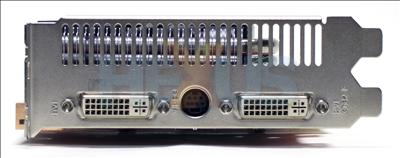Card appearance
Take a gander at our reference review to appreciate what makes a Radeon HD 4870 tick along.
PowerColor's HD 4870 1GB PCS+ differentiates itself from the reference Radeon HD 4870 through the use of an uprated, PowerColor-branded ZEROtherm cooler and increased clockspeeds of 800MHz core and an effective 3,700MHz memory, faster, naturally, than stock clocks of 750MHz and 3,600MHz.
It looks as if someone was on the sauce at the PowerColor factory; the cooler's sticker, and indeed heatsink, is the wrong way around, it appears.
The card also provides a 1GB framebuffer, twice that of the reference design, and it should play well when resolution and image-quality settings are increased.
Looking at the back of the card reveals no additional memory chips, so the additional capacity is clearly achieved using higher-density memory GDDR5 modules, situated on the front.
The ZEROtherm cooler is a dual-slot unit that utilises two s-shaped heatpipes to direct the GPU's heat output towards the two fin-arrays which are located either side of the central 80mm fan. The memory, however, is covered by simple heatspreaders, and seems overlooked in comparison to the core's cooling.
The heatsink-and-fan assembly found on the HD 4870 reference design is notorious for keeping the GPU pretty toasty, prioritising quiet operation over lower temperatures. PowerColor promise a 10°C drop in temperatures compared to the reference design, which may also suggest increased overclocking potential.
The card also requires two six-pin PCIe power connectors. PowerColor suggests the use of at least a 500W PSU for single-card use and 600W for dual-card CrossFireX operation.
Rear connectivity is provided for by two dual-link DVI ports and a TV-out connector. HDMI (with audio), VGA, component and composite outputs are also provided through use of the supplied dongles.








